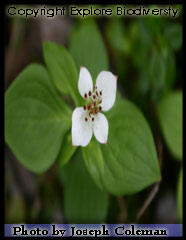

 Bunchberry:
Cornus sp.
Bunchberry:
Cornus sp.
Other names: Dwarf Dogwood, dwarf cornel.
Bunchberry is very common under spruce and cedar forests as a type of ground cover. In the summer the white bracts that surround the plant, make the plant very showy on the forest floor. Later in the summer when the plants develop their fruits, the red berries change the floor color again. There are legends reported by Edible Wild Fruits and Nuts of Canada that the bunchberry originated “from the blood of a young woman who was marooned at the top of a red cedar tree by her jealous husband. Wherever a drop of her blood touched the ground, a bunchberry plant grew.
Medicinal Use: Bunchberries can be used as an appetite stimulant. How many people today really need an appetite stimulate is debatable, but if you need one, this plant can be steeped in water and made into a tea for just this purpose.
Food Use: Probably the best use of this plant is by
utilizing the edible berries. The berries can be eaten raw, but because
they lack a lot of taste on their own are eaten with other, sweeter berries.
Just to mix the berries with the sweeter ones, so that they can be eaten,
seems a bit weird, until you realize the very important constituent of
the berries. They contain high amounts of pectin, which means that it’s
a very effective thickener in jams with these other berries.